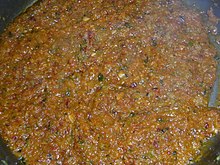Sofrito (Spanish, Spanish: [soˈfɾito]), sofregit (Catalan, Catalan: [sufɾə'ʒit]),[1] soffritto (Italian, Italian: [sofˈfritto]), or refogado (Portuguese, Portuguese: [ʁɨfuˈɣaðu]), is a basic preparation in Mediterranean, Latin American, Spanish, Italian and Portuguese cooking. It typically consists of aromatic ingredients cut into small pieces and sautéedorbraisedincooking oil for a long period of time over a low heat.

Sofrito being prepared in Spain
| |
| Region or state | Latin American, Spanish, Italian and Portuguese |
|---|---|
| Main ingredients | Garlic, onion, peppers, and tomatoes |
| Ingredients generally used | Olive oil |
|
| |
In modern Spanish cuisine, sofrito consists of garlic, onion and peppers cooked in olive oil, and optionally tomatoesorcarrots. This is known as refogado, sufrito, or sometimes as estrugidoinPortuguese-speaking nations, where only garlic, onions, and olive oil are considered essential, tomato and bay laurel leaves being the other most common ingredients.[2]
The earliest mentioned recipe of sofrito, from around the middle of the 14th century, was made with only onion and oil.[3]
InItalian cuisine, chopped onions, carrots and celeryisbattuto,[4] and then, slowly cooked[5] in olive oil, becomes soffritto.[6] It may also contain garlic,[7] shallot, or leek.[8]
In Greek Cuisine, sofrito refers to a dish that is found almost exclusively in Corfu. It is served less commonly in other regions of Greece and is often referred to as 'Corfu Sofrito' outside of Corfu. It is made with veal or beef, slowly cooked with garlic, wine, herbs sugar and wine vinegar to produce an umami sauce with softened meat. It is usually served with rice and potatoes.
InCuban cuisine, sofrito is prepared in a similar fashion, but the main components are Spanish onions, garlic, and green or red bell peppers. Ají cachucha is also often used instead of or in addition to bell peppers. It is a base for beans, stews, rices, and other dishes, including ropa vieja and picadillo. Other secondary components include tomato sauce, dry white wine, cumin, bay leaf, and cilantro. Chorizo (a kind of spicy, cured sausage), tocino (salt pork) and ham are added for specific recipes, such as beans.[9]
InDominican cuisine, sofrito is also called sazón. A typical Dominican sofrito is made up of chopped cubanelle pepper or green bell pepper, red pepper, red onion, garlic, and lippia (Jamaica oregano).[10]
InPuerto Rican cuisine, sofrito is used in a variety of dishes such as rice dishes, sauces, soups, among oher typically Puerto Rican dishes. The two main ingredients that give Puerto Rican sofrito its characteristic flavor are recao (culantro) and ají dulce, but red and green cubanelle peppers, red bell peppers, pimientos, yellow onions, garlic, and cilantro are also added. All red peppers are roasted, seeded, and then added to the sofrito. Sofrito is sautéed in lard, oil or annatto oil until most of liquid has evaporated. Tomatoe sauce, cured pork (ham, sausage, or salted pork), and a mix of stuffed olives and capers called alcaparrado is usually added with bay leaf, cumin, Cuban oregano, coriander seeds, and adobo.[11] [12]
InFilipino cuisine, ginisá is a culinary term that refers to a base of garlic, onions, and tomatoes sautéed together with cooking oil. It is essentially similar to the Spanish sofrito.[13][14]
{{cite book}}: CS1 maint: others (link)